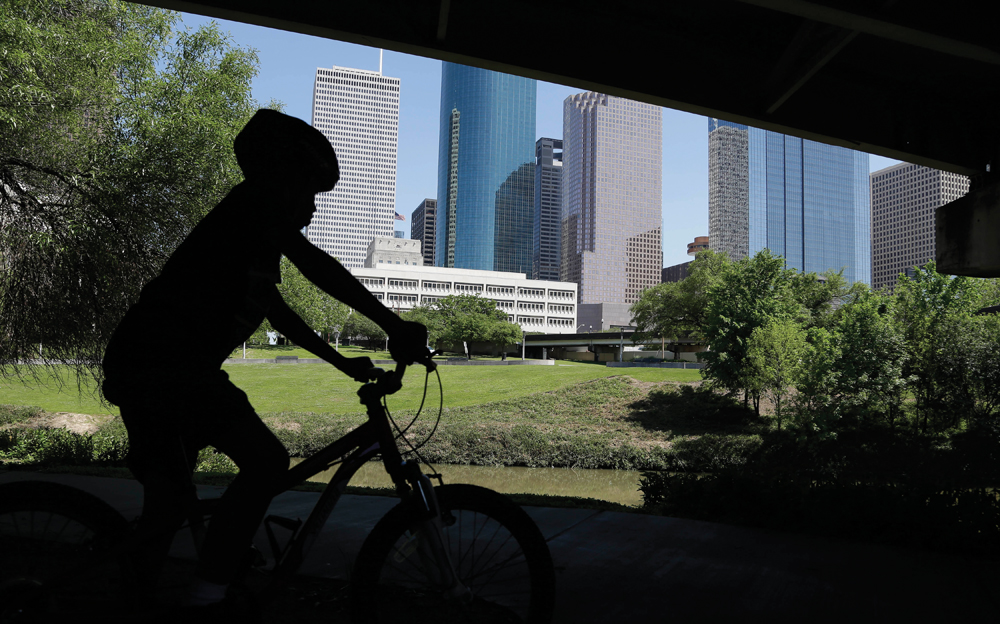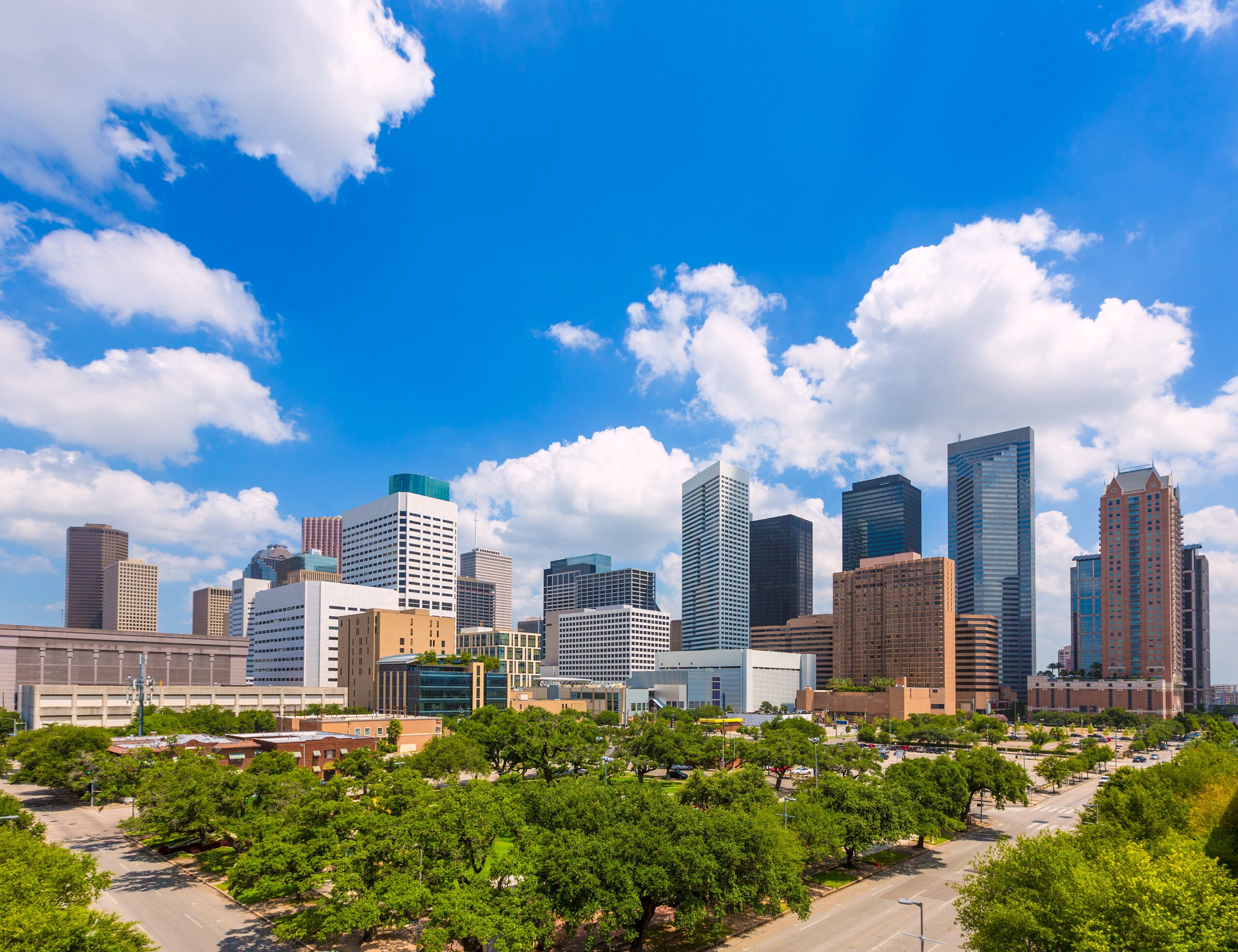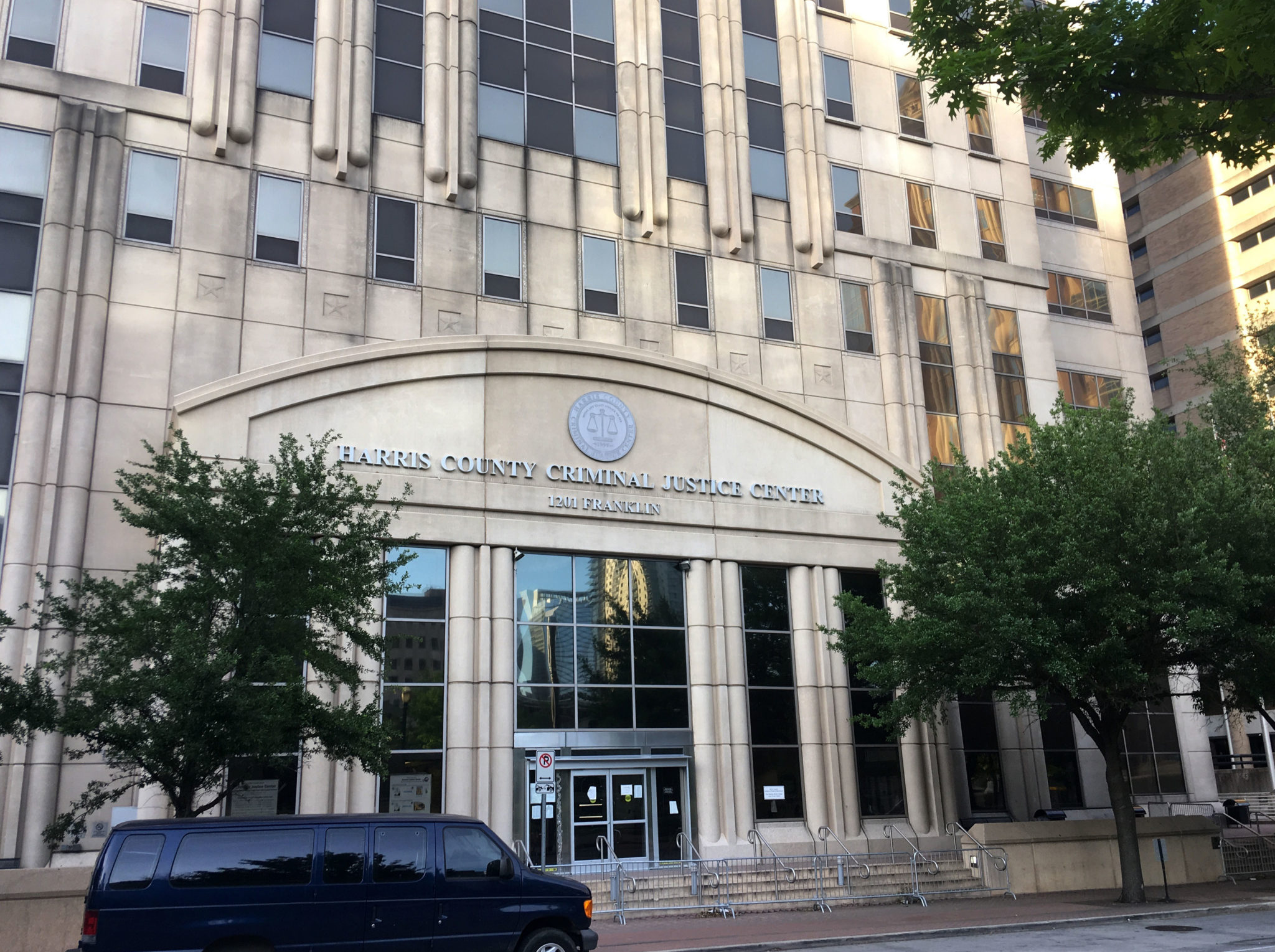
Back in the Saddle
Can the state’s quintessential car capital be made bike-friendly?
A version of this story ran in the July 2015 issue.
Above: A boy rides his bicycle along Houston’s Buffalo Bayou. The city and the nonprofit Buffalo Bayou Partnership are spending $58 million to improve the waterway and the surrounding parks and bike and jogging trails.
How about you, riding a bike, in Houston?
You came to Houston to listen and learn about promise, or so you’d hoped. On a cool but clammy Sunday morning, you arrive at downtown’s Market Square Park with a couple dozen other cyclists. As you straddle your bike, you watch a tall, trim man with flecks of graying hair climb onto a decorative concrete bench. The man, a current Houston City Council member, addresses the crowd gathered around you. “I’m Steve Costello, and I’m running for mayor,” he says. He tells the people here for the ride that he wants to see an expansion of the city’s bike-share system. He tells the crowd he is an avid triathlete, but that this is his first time on a mountain bike, and he’s a little nervous. Later, he tells you that to train for those triathlons he drove 20 miles outside of town to ride his bike.
Then another man stands up on the bench, and this man says he’s running for an at-large City Council seat. His name is Tom McCasland. He’s the head of the Harris County Housing Authority, and he’s a board member of Houston’s cycling advocacy group, BikeHouston. In the past year, in the wake of much tumult in the Houston cycling community, BikeHouston has grown from 80 to more than 800 members and hired three full-time employees, including a new executive director, Michael Payne, who is also riding today.
The ride hasn’t even begun, but already the assembled political muscle is impressive. Bicycling in Houston, it seems, matters.
You follow Tom and Steve and Michael as they lead the group of bicyclists through canyons of gleaming glass skyscrapers and onto a concrete path bordering Buffalo Bayou. This waterway—in parts idyllic river, in parts drainage ditch—is the thick spine of a sprawling system of marshy tributaries and concrete-lined creek beds that funnel water throughout Houston’s 600 square miles and into the Gulf of Mexico. It’s this system of tributaries, and the ever-expanding network of paved hike and bike trails that follow them, that you’ve come to see. These trails, people tell you, will form the core of a comprehensive cycling network. And that network, people say, will tie communities together, curb obesity, clean the air, and maybe even help alleviate Houston’s ever-snarled traffic.
This trail system, along with simple but practical park amenities including manicured green spaces and picnic tables and benches and public art, is what Houston voters overwhelmingly asked for when they approved $100 million in bond funding three years ago as part of the Bayou Greenways 2020 initiative. That bond was followed by $115 million in private donations. Before you came to Houston to ride beside these bayous, you didn’t realize that the initiative’s lofty goal—to complete 150 miles of paved trails along Houston’s 10 main bayous by 2020—was actually being met. But by the time you reach the turn-around point of the ride, which is held each month to showcase Bayou Greenways’ progress, you’ve ridden 15 miles. You’ve pedaled along brushy creek beds and watched egrets and fish leaping from the water. You’ve crossed a brand-new bike-ped bridge that links a trail running from the majestic oaks of the Houston Heights neighborhood to White Oak Bayou. And you’re kicking yourself, as you sweat and chafe, for wearing jeans and loafers.
Who knew you could get this far from downtown Houston without a car?
As you head back into a headwind, you ride beside a man named Dick Weekley, the co-founder of David Weekley Homes—he’s David’s older brother. He’s in his late 60s, tan and lean, and wearing the cycling jersey of his namesake business. His muscular calves look like dinner plates wrapped in skin. You know the name Weekley from the billboards, “Homes starting from the $150s,” which make your stomach churn, because to a cyclist they signal suburban sprawl—developmental cul-de-sacs that funnel cars onto clogged arterial roadways with scant bike lanes.
Weekley’s business, and the demand for it, is one reason you might have to drive 20 miles out of town to train for a triathlon.
But Weekley is a philanthropist, too. He tells you that 17 years ago he was instrumental in the formation of a group of local business leaders and politicians called the Quality of Life Coalition. Through his influence, his hard work, and his money (“Whenever we needed funding, we’d pass the hat around”), he’s partly responsible for the trails we’re riding right now. He’s been doing group rides such as this one, exploring the potential of the green space along Houston’s bayous, since these trails were just dirt tracks.
You’ve probably read the criticism, reported more than a decade ago in this magazine, that Weekley has long owned land fronting Buffalo Bayou, and so stands to profit from the parks projects. Ask Weekley about the motivation for his involvement and he bristles. He says he never would have invested in that property, 12.3 acres split by the Elysian Viaduct, if he’d known people would infer that he was after simple personal enrichment. He points at the moms and dads pushing strollers and the wobbly kids riding bikes and he asks: Really, what more motivation do you need?
Houston, the fourth-largest city in the nation, will become bikeable.
As you pedal your way into downtown, you feel the endorphin-fueled good mood that comes with exercise. You think, sure, there’s a long way to go, but Houston could do this. Houston wants to do this. Houston, the fourth-largest city in the nation, will become bikeable.
Then, weeks later, on Memorial Day, as you scroll through your Facebook feed, you learn about a man from Houston, a father of three, a longtime cyclist and a leader at his church, David Rosenfeld, 47, who died that morning when he was hit by a car. Rosenfeld was riding to a memorial ride for a cyclist who had been struck by an inattentive motorist. The irony, so sad, so not-funny, affects you physically, and your chest feels heavy, and your head feels light, and tears well in your eyes.
And as you grapple with the senseless loss, you read the horrible and apparently obligatory comments that accompany such stories. Comments that say cyclists shouldn’t be on the road anyway, and it’s their own fault when they get hit. That cyclists run red lights and cut in traffic. The comments make you wonder when the onus of safety shifted from the person operating the deadly vehicle to the victim, and what scofflaw cyclists (who irritate law-abiding cyclists, too) have to do with David Rosenfeld, who wasn’t breaking any laws when he was killed. And you think, sure, there’s promise for cycling in Houston, but people who already ride bikes in this city need help now.
Increasingly, major American cities are compelled to care about bicycling. On our bayou bike ride, mayoral candidate Costello talked about changing demographics. About how Houston’s oil- and gas-driven economy, one of the strongest in the nation following the 2008 meltdown, has drawn thousands of new residents from across the country and around the world. Many of these newcomers are young, talented and educated, members of the oft-cited “creative class,” the much-sought-after golden children of the new information-based economy. Costello says that for these people, good money isn’t enough. When choosing a city in which to live and work, they also value amenities such as outdoor space, recreational opportunities and a diversity of transportation options, including walking and biking. If Houston wants to keep these workers, if it wants to compete for talent with cities such as New York and Chicago and Los Angeles—all of which have transformed themselves into top cities for urban cycling over the last decade—then it too must provide these amenities.
For decades, Houston’s insecurity about the sustainability of its economic might, predicated on the most unsustainable of resources, has been evidenced by its official slogans. There was the unfortunate double entendre of “Houston’s Hot,” the painfully plain “Houston: Energy Capital of the World,” and the vaguely creepy “Houston: Expect the Unexpected.” City officials and business leaders imposed these mottos on Houston. But lately, Houstonians—especially those in central Houston, within the 610 loop—have generated their own expression of populist pride, as seen on T-shirts, stickers and other paraphernalia about town, that simultaneously acknowledges and dismisses outsider doubt: “Fuck You, Houston’s Awesome.”
That sentiment, and its fulfillment, is evident in the ongoing revitalization of Houston’s downtown, in the collective of owners who’ve opened 13 hip new downtown bars in the last two years, and in communities along the Bayou Greenways, where wildflower gardens have been planted and canoe launches organized to celebrate the opening of new green space. It’s also evident in the rise of urban cycling culture, including the thousands of cycling citizens and families who come downtown on the final Friday evening of each month to participate in Critical Mass rides, and the multitude of social rides (often with taco stops) that take place weekly.
The (still relatively paltry) number of bicycle commuters in Houston doubled from 2012 to 2013, from 0.4 percent of the city’s 2.6 million residents to 0.8 percent.
Houstonians and recently arrived “Newstonians” are embracing biking in growing numbers. According to the most recent census data, the (still relatively paltry) number of bicycle commuters in Houston doubled from 2012 to 2013, from 0.4 percent of the city’s 2.6 million residents to 0.8 percent. In most major cities, more cyclists leads to safer cycling, as driver awareness increases. Yet Houston cyclists continue to be struck by vehicles at an alarmingly high rate. A recent public information request to the Houston Police Department by the Houston Press showed that there were at least 950 crashes involving bicyclists in Houston from May 2013 (when the city’s 3-foot passing ordinance was implemented) to April 2014. Of those crashes, 213 were hit-and-run incidents—a clear indicator, bike advocates argue, that Houston drivers harbor little concern for other road users.
The most publicized of these hit-and-run incidents occurred on Dec. 1, 2013. The victim’s name was Chelsea Norman. She was 24, and she was riding her bike home from her job at Whole Foods Market in the narrow, debris-littered bike lane on Waugh Drive when she was struck by a car and left to die.
Her death galvanized the Houston cycling community. Hundreds of cyclists showed up at a memorial ride in Norman’s honor, handing out flyers to motorists to explain why they were clogging the streets. BikeHouston, then a tiny and completely volunteer-staffed organization, demanded action from the city. Mayor Annise Parker appeared to be listening.
Parker, whose vocal support of cycling in Houston had not previously resulted in meaningful change, commanded the police department to ramp up enforcement of the recently enacted safe-passing ordinance, which requires drivers to give cyclists a 3-foot berth when passing, and pedestrians 6 feet. Parker partnered with BikeHouston on a Goal Zero initiative, an idea first popularized in Sweden and recently adopted by bike-friendly cities such as New York and San Francisco, that aims to raise driver awareness and reinforce the premise that when you operate a vehicle (motorized or otherwise), you’re responsible for the lives of other humans. Parker also hired a new director for the city’s Planning and Development Department, a cyclist (and motorist and user of public transportation) named Patrick Walsh, and put city money toward the development of a new bicycle master plan.
If there’s one reason Houston’s cycling infrastructure is so far behind the cities with which it hopes to compete—why its hundreds of miles of dangerous, narrow bike lanes seem prehistoric when compared to other cities’ modern, protected bike lanes, which use concrete curbs and plastic pylons to create a physical barrier between drivers and cyclists—it is because Houston has never really planned to be bikeable.
The last citywide plan for cycling was drafted back in 1997, and carved out space for the handful of experienced Houston cyclists who were already braving the city’s streets. The new plan will aim to create a safe and accommodating bike network for residents ranging in age from 8 to 80, catering to all the Houstonians who say they want to ride (more than 50 percent, according to BikeHouston) but don’t feel safe doing so.
I meet Cathy Halka, the woman tasked by Patrick Walsh with creating a plan to make Houston bikeable, at a place I didn’t expect to find here: the Houston Bicycle Museum. Located in the Museum District, blocks from the Museum of Fine Arts and the gardens of Hermann Park, the Houston Bicycle Museum occupies a temporary space in a former bank building. (The plan is to raise enough money over the next year or so to construct a permanent building on a nearby property.) Old photos and informational placards about the bicycle’s history in the U.S., in Texas and in Houston grace the walls. In one black-and-white image from 1897, a few dozen stoic-faced members of Houston’s Lord’s Cycling Club stand outside their two-story clubhouse at 109 Chenevert St. (now a parking lot near downtown’s Minute Maid Park). Nearby, a turn-of-the-century bicycle with wooden rims stands on display.
Halka is in her early 30s and has chestnut hair and brown eyes and a warm smile. She grew up in this neighborhood, then studied urban planning at the University of Maryland and earned a Fulbright fellowship to study in Lithuania. In Sugar Land, the fast-growing Houston suburb where she previously worked as a senior planner, she was anointed employee of the year for helping develop a bicycle and pedestrian master plan there. She and her husband and their young daughter now live in the Museum District. She’s been on the job in Houston for only four months. She rides a bike, she says, but she doesn’t wear Spandex, nor does she identify as a cyclist. Her bike has a basket. Cycling isn’t a lifestyle for Halka; it’s just how she gets from point A to point B when she’s not driving or walking.
If there’s one reason Houston’s cycling infrastructure is so far behind the cities with which it hopes to compete it is because Houston has never really planned to be bikeable.
When I tell her I’m here to explore Houston’s promise as a bikeable city, she smiles and says, “Yes, there’s lots of promise.” She tells me that the bicycle master planning has only just begun, but she can confirm that the Bayou Greenways will form the backbone of the city’s bicycle network. She’s excited about a pilot project to build trails in Houston’s utility corridors, which run north to south through the city. The easements were made available for trails through bipartisan legislation at the Capitol, which mitigated the utility company’s liability.
We talk about the Lamar Street cycle track, a protected bike lane that was installed in March and spans the length of downtown Houston from Discovery Green to Sam Houston Park. Though cyclists have complained that construction projects and delivery truck drivers often block the route, and that mounted police officers leave piles of horse poop in the lane, the track does provide a sense of security amid downtown’s chaos of cars.
“I think it shows Houstonians what types of designs there are for modern bicycle infrastructure, and it gives them the opportunity to experience them,” Halka says.
I ask Halka what challenges she anticipates with the new bike plan, and she talks about the potentially difficult conversations around giving bikes room on Houston’s roads. Lanes presently dedicated to motorized vehicle traffic will have to go away to make space for new, wider and safer bike lanes. Perhaps most contentious of all, some parking may disappear downtown and on neighborhood streets where new bike lanes are installed. Halka describes an effort in Sugar Land to “right-size” a key corridor from four lanes to two and install wide bike lanes. She was excited about the plan, but the community objected. And she had to put the community’s wishes first.
“Ultimately, that is who you are planning for,” she says. Community engagement, listening to the community, she says, is the most important thing.
I mention that, in the wake of David Rosenfeld’s death, I reached out to BikeHouston Director Michael Payne. He told me there’s a growing sense of frustration about the pace of change. People who ride bikes in Houston want to know what can be done right now to address the lack of significant cycling infrastructure and the recklessness of inattentive and irresponsible motorists. In other major cities, such as New York and Chicago, forceful leaders have made fast and profound changes to their transportation networks. New York’s transportation commissioner, Janette Sadik-Khan, eschewed prolonged planning studies in favor of experimenting with paint and pylons, pouring concrete if the experiments proved successful. Chicago Mayor Rahm Emanuel spearheaded construction of 100 miles of new high-quality bike lanes in his first four years in office.
Halka tells me that the planning department, in collaboration with a consulting firm, is preparing an existing-facilities report, due in mid-August. She says the report will identify immediate safety concerns and recommend pilot projects to correct the problems.
There’s also Mayor Parker’s Goal Zero initiative, the goal of which is to reduce traffic fatalities to zero. But it’s unclear whether that’s a mere for-show promise or a sincere commitment. Two years after Chelsea Norman’s death, the Houston Police Department had issued fewer than a dozen citations to drivers for violating the city’s safe-passing ordinance. A “Share the Road” public service announcement has received a little more than 2,000 views on YouTube. Payne notes that in New York City, a similar safety campaign resulted in a reduction of speed limits to 25 miles per hour citywide, and a 40 percent increase in the number of speeding tickets issued in the initiative’s first three months.
As Halka and I talk, it occurs to me that she is one of those young, talented and educated workers that Houston so eagerly seeks. She obviously loves her city, she came back to it, and she’s working hard to make it a place where she wants to live. If she can’t do that, if she can’t one day ride her daughter to school, or safely make it from her neighborhood to the nearest park by bike, I wonder, will she stay?
As we finish our conversation and move toward the museum’s exit, a woman with long gray hair and a long, beaded necklace greets us. Her name is Joy Boone, and she spent years collecting the historical bicycles on display here. Almost 50 years ago, she and her husband, Daniel Boone, opened Daniel Boone Bicycles, located just around the corner, and for years it has been a hub for Houston’s cycling community.
Joy tells Cathy about how, decades ago, the Houston cycling community first convinced the city to stripe all those narrow and debris-filled bike lanes that everyone thinks are so crappy now, and how at the time it felt like a huge victory, like a better city for cycling was just around the corner. Joy says that she hasn’t really ridden in decades, and that now she sees kids in the Montrose neighborhood riding on the sidewalks, and she doesn’t understand why. They should be more confident and ride in the road, where vehicles belong, she says. Cathy agrees that bicyclists absolutely have a right to the road. She says that better cycling infrastructure will give novices some room for comfort around cars and, hopefully, the confidence to get out on the road.
Then Cathy writes her name and phone number on a piece of paper. She hands it to Joy and looks her in the eye. “I want to hear from you,” she says. “If you have any questions, comments or concerns about the future of cycling in Houston, please, call me.”


